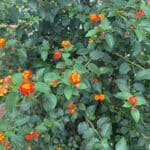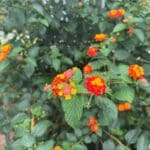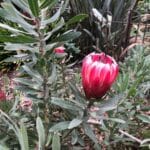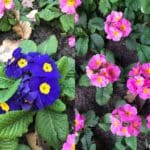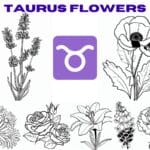Oncidium orchids, more commonly known as the dancing lady orchids or golden shower orchids, are popular ornamentals known for their attractive flowers.
Although orchids, in general, are always recognized for their exotic beauties, Oncidiums have captivated many florists and orchid collectors alike because of their long and large spikes of delicate blooms that gave them the name “dancing ladies” (1).
Read on below to know more about the beautiful Oncidium orchids.
Facts About Oncidium Orchids
Oncidium is a large genus in the Orchidaceae family with over 750 plant species that vary in size, color, and fragrance. The genus name originates from the Greek word onkos that means “swelling” and refers to the prominent callus growth on the flower’s lip.
These plants are called the dancing lady orchids or dancing ladies because of their showy flowers that sway gently as the wind blows, somehow mimicking a dancing lady.
They are also known as the golden shower orchids, spray orchids, bee orchids, and tiger orchids.
They are native to Mexico and Brazil (3). But ,from Florida and the Caribbean to Central and South America, Oncidiums can be found.
Plant Description
Most Oncidium orchids and their hybrids are sympodial epiphytes, but some species are terrestrial or lithophytes. They typically grow between 30 cm to 3 m in height and 20 to 60 cm in width, depending on the species.
For most Oncidium species, flowering occurs in autumn to winter. The magnificent flowers often come in shades of yellow and brown, but other different colors are available as well, including white, pink, magenta, and red (2).
Individual flowers are small, with each measuring about 6mm to 10 cm in diameter, and grow on multiple branched sprays from a single plant.
They grow pseudobulbs, in which one or more leaves emerge. Depending on the species, the leaves can either be soft, small, and pencil-like or large, thick, and leathery (2).
Popular Oncidium Orchids Species
Oncidium varicosum

Common names: The Veined Oncidium, Strap Leaf Oncidium, Dancing Lady Orchid
The Veined Oncidium (O. varicosum) is a species of orchids grown from Brazil, Paraguay, Bolivia, and the northern part of Argentina at elevations of 500 m to 1800 m.
They are medium-sized epiphytic orchids that reach a height of 19 to 38 cm. The leaves are lanceolate and grow up to about 23 cm long.
This Oncidium species commence flowering in the fall and winter, showcasing dull yellow flowers with bright red and brown stripes and large, bright yellow lips. The flowers are non-fragrant and vary in size, but not larger than 3.8 cm in diameter.
The Veined Oncidium orchids are popular cut flowers, commercialized on a large scale because of their potential. They are believed to be the original dancing lady orchids because of their delicate flowers.
Oncidium sphacelatum
Common names: Burnt Spot Oncidium, Kandyan Dancer Orchid
The Burnt Spot Oncidium orchids are large-sized, warm-growing, epiphytic species native to Mexico, Central America, and Venezuela at elevations below 1000 m. Each plant reaches up to 60 cm long and 60 cm wide.
These orchids commence flowering in spring, showcasing an abundance of tall and impressive inflorescence with each flower spike holding dozens of bright yellow blooms.
Individual flowers measure up to about 2.5 cm. The yellow green leaves of this Oncidium species are oblong and semi-leathery, while the pseudobulbs are ovoid.
Oncidium flexuosum
Common name: Dancing Doll Orchid, Bent Oncidium
Oncidium flexuosum, otherwise known as the Dancing Doll Orchid or the Bent Oncidium, is a small- to medium-sized Oncidium orchid species native to Brazil, Argentina, Uruguay, and Paraguay.
The plants grow up to 30 cm in height with narrowly ovoid pseudobulbs and narrowly oblong-ligulate, shiny, and pointed leaves that are 10 cm to 23 cm long.
They start flowering in the fall and winter on erect inflorescences that hold ten small, bright golden yellow flowers each. Individual flowers grow up to 2 cm to 25 cm long with a large yellow lip that has a red-brown lump.
Oncidium cheirophorum
Common names: Hand Carrying Oncidium, Twinkle Oncidium, Colombia Buttercup
The Hand Carrying Oncidium (O. flexuosum) is a miniature, fragrant species of Oncidium orchids that can be found in Mexico through Central America to Colombia.
This particular species carries small, buttery yellow flowers that measure about 1.5 cm at most and bloom in fall.
Some of the most recognized cultivars of this species include the following:
- Onc. cheirophorum ‘Kyle’
- Onc. cheirophorum ‘Patricia’
- Onc. cheirophorum ‘Marburg’
- Onc. cheirophorum ‘Lenny and Bobbie’
- Onc. cheirophorum ‘Popcorn’
- Onc. cheirophorum ‘Gerli’
- Onc. cheirophorum ‘Woodstream’
- Onc. cheirophorum ‘Free Spirit’
- Onc. cheirophorum ‘Michael’
- Onc. cheirophorum ‘Merry’s Gold’
- Onc. cheirophorum ‘Melemele’
Oncidium leucochilum
Common Name: White-lipped Oncidium
One of the most popular species of Oncidium orchids is the O. leucochilum, recognized for its beautiful flowers with distinct chocolate markings and contrasting white lip.
The White-Lipped Oncidium orchids are large-sized, epiphytic orchids that can be found from Mexico to Guatemala and Honduras at an elevation of 2000 m.
They bloom in spring or fall with 7 to 10 spice-like fragrant flowers that measure up to 3 cm wide. Each inflorescence measures about 30 cm to 70 cm long.
Oncidium longipes
Common Name: Long Column Foot Oncidium
The O. longipes, otherwise known as the Long Column Foot Oncidium, is a dwarf species of orchids found in Brazil, Peru, and Paraguay.
A close relative of O. uniflorum and O. regentii, this species grows at least 20 cm in height with an inflorescence shorter than the two soft, oblong leaves. Two to three large flowers, measuring about 3.5 cm wide, grow on short racemes.
Oncidium sarcodes
Common Name: Fleshy Oncidium
Also from the rainforests of Brazil are the Oncidium sarcodes orchids. They are medium-sized epiphytic orchids that showcase fascinating blooms in the spring.
Individual flowers can grow up to 5 cm wide and come in shades of bright yellow, red, maroon/burgundy, and brown. A fully matured plant of this species reaches a height of 30 cm to 45 cm.
Growing Oncidium Orchids
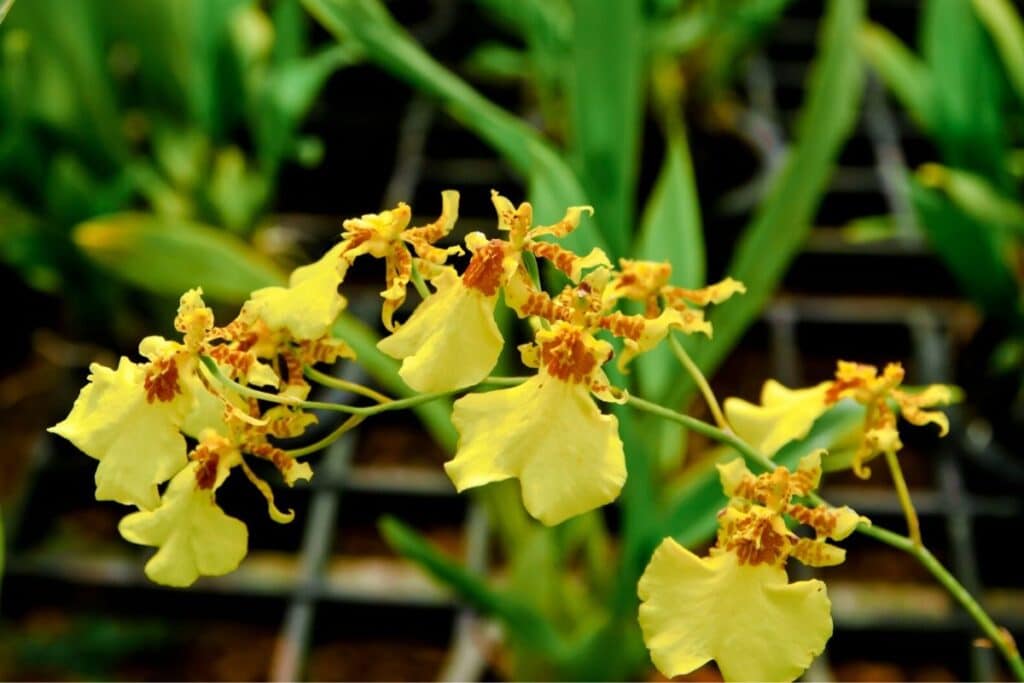
Oncidiums are easy-to-grow orchids, even if you are a complete beginner in gardening. The key to successfully growing one is providing them with the right environmental conditions.
Below you’ll find basic information about the requirements when growing these beautiful ornamental plants.
Light
Unlike low light orchids such as Paphiopedilums and Phalaenopsis, Oncidium orchids and their hybrids prefer bright light conditions. Their leaves should be bright green and not dark nor reddish.
Bright green leaves mean that the plant is healthy and receives sufficient light. Dark green leaves indicate that there’s not enough light, while reddish-green leaves indicate too much light.
Depending on the species, light requirements can range from bright to nearly full direct sun. Many oncidiums will also grow under artificial light.
Temperature
They need a temperature range of 55-60°F (13-16°C) at night and 80-85°F (26-30°C) during the day. Temperatures as high as 95-100°F (35-37°C) can be tolerated, provided humidity and air movement increase as temperatures rise.
Humidity
Dancing lady orchids require between 55% to 75% humidity. One way to increase humidity is by placing the plant pot on a flat surface, like a tray, filled with pebbles or rock chips and water (1).
Note, however, that the water level should be below the top of pebbles so that the plant’s roots will not be submerged. Misting the leaves in the morning can also increase humidity.
Water
Proper watering is vital to the growth of Oncidiums or any other type of orchids. Like other orchid species, these plants need more water when growing new shoots and less once the bulb has formed. Overwatering will likely cause more harm than good since their fleshy roots are prone to root rot.
Every two to ten days, when the planting media is half dry, water the plants well with tepid to room temperature water. Keep the potting medium dry slightly between watering periods (1).
Plants that are not actively developing should be watered less often; many Oncidium species have winter rest periods.
Fertilizer
Fertilize your Oncidium orchids at least once a month with a complete 20-20-20 fertilizer or 30-10-10 orchid fertilizer. Then, reduce fertilizing as soon as flowering stops until new leaves emerge. It is important to avoid overfertilization since it could damage or kill the plant (1).
Potting
Ideally, Oncidiums should be repotted at least every two years. Their plant size and growing medium are also good indications of whether or not the orchid plant needs repotting. It is either when the pot becomes too small for the plant’s new growth or the compost becomes broken down. The bottom line is to repot when necessary.
When repotting a dancing lady orchid plant, you should allow sufficient space for the plant to grow new roots and pseudobulbs. Remove any dead roots and divide the pseudobulbs in clumps of three to five.
Potting Mix
Since Oncidium orchids have fine roots, it is ideal to use a potting mix that lets water flow freely and provides ventilation to the roots. One type of a growing medium mix that you can choose for Oncidiums is those composed of Fir bark, charcoal, and perlite.
FAQs
Do oncidiums like small pots?
Oncidium orchid generally prefers smaller pots, as it appreciates a snug fit for its root form. However, it’s crucial to provide adequate drainage to prevent waterlogging, and repotting should be done when the orchid outgrows its container or when the potting medium breaks down.
How do I get my Oncidium orchid to bloom?
To encourage your Oncidium orchid to bloom, provide it with the right conditions. This includes bright but filtered light, a well-draining orchid mix, a temperature drop in the evening, and regular fertilization during the growing season. Ensure a proper dormancy period by adjusting the temperature and reducing watering in the winter to promote the development of flower spikes.
References
Reference list
- Web.extension.illinois.edu. (2020). Growing Orchids. [online] Available at: https://web.extension.illinois.edu/hortihints/0204d.html
- Oaji.net. (2020). [online] Available at: http://oaji.net/articles/2016/491-1468999276.pdf
- Aggie-horticulture.tamu.edu. (2020). Orchidaceae or Orchid Family. [online] Available at: https://aggie-horticulture.tamu.edu/syllabi/302/new/family/orchidaceae.html
Close
*Photo by bewitch/depositphotos

